How to plant bare root trees
Buying trees “bare root” for planting in the Winter months can be the cheapest way of adding large (and often expensive) plants to your garden.
But if you’re new to the concept, it can seem a little overwhelming, compared to simply buying a plant in a container. Here’s our overview to bare root trees, and how best to plant them…
What is a bare root tree?
“Bare root” simply means that the tree doesn’t have any soil around its roots. The trees have been grown in the open ground and are then dug up, the soil removed from their roots, and parcelled ready to despatch. The roots are usually wrapped in plastic, to prevent them drying out, and they arrive ready to be planted straight out into their new position. It is a common way of selling many trees, especially fruit trees and hedging, and is a cheaper alternative than buying trees in containers.
When to plant bare root trees?
Bare root trees are planted when they are in their dormant season, in other words the Winter months. Avoid planting trees out when the soil is waterlogged or frozen, but any other time will be fine.
Try to plant your tree as soon as it arrives; even if wrapped up carefully, the roots will start to dry out after a while, and need to be back in the dark, moist conditions of the soil as soon as possible. If they’ve arrived and you won’t be able to plant them within the next couple of days, then “heel them in” in the meantime. Either put them in a big plant pot with compost, or dig a trench in the ground and heel them in here.
How to plant
Preparation:
Tree planting is easiest with two people, so one can hold the tree upright and ensure it stays straight, while the other back fills the hole. It is possible on your own, but you will need to make sure you have everything in reaching distance and that you hold the tree in line carefully!
If you are planting a bare root, standard tree, you will need to stake it. If you’re planting a multi stem, it shouldn’t need a stake, so just follow the planting instructions below without the staking part.
You will need a spade, and, for a bare root, standard tree, a tree stake about a third the size of the stem, a tie and a soft rubber mallet.
If you’re planting a few trees at a time, for example as hedging or in an orchard, then do make sure that the roots don’t dry out in the sun or wind, which can happen surprisingly easily. Keep each tree in its plastic bag until it is time to plant.
Planting:
Dig a hole to the depth of the pot, or to the depth of the longest root and roughly twice as wide as the pot or the root spread.
Position the tree in the hole and turn it so that its most attractive side is facing the direction it will most often be seen. (Towards your own house, rather than to the back of the fence for example.) This is when it helps to have someone else holding the tree for you, so you can step back and check…
Position it at the correct height. It should stay the same distance above and below the soil as it has been in the open ground. Check the trunk for a mark where you should be able to see where the soil has been and position this at ground level again.. The “root flare” – the slightly larger area where the roots begin to flare outwards – should be sitting just on the top of the soil.
Hold the tree in place and carefully insert the stake on the side of the trunk where the wind direction usually blows from (you want the stake to be holding the tree up from the opposite side to that which it might be falling in heavy winds…) Position the stake a few inches away from the tree. Push it into the ground taking care not to damage any roots (if you are planting on your own, you would need to put the tree down for this part and put it back up into place afterwards.) Use the mallet to push the stake into place, until it is very secure.
Still holding the tree upright, carefully secure the tree tie around the trunk, just below the top of the stake, and making sure it is tight enough that it won’t shake and rub in the wind, but not so tight it will start to cut into the tree.
Back fill the hole with soil, firm in and water well.
For the first year, the tree will need to be well watered during any dry spells. Check the tree tie occasionally to make sure it isn’t rubbing against the trunk as the tree is growing.
The tree stake can be removed after a year, when the roots should be secure enough to hold the tree firmly in place.






